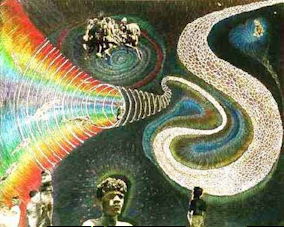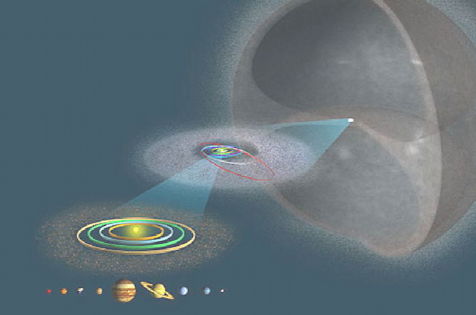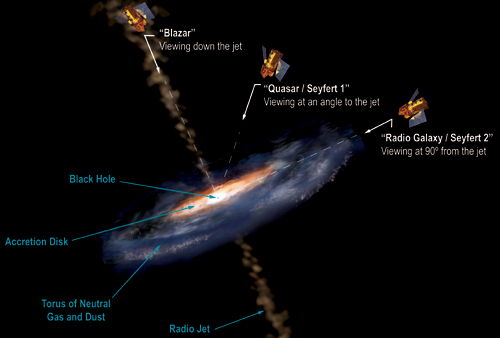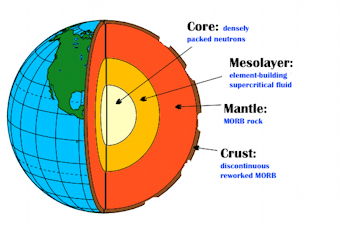
William of Ockham. From [1].
The Ockhamized Universe --
The new explanation of the physical cosmos
David Noel
<davidn@aoi.com.au>
Ben Franklin Centre for Theoretical Research
PO Box 27, Subiaco, WA 6008, Australia.

| Question | Old View | New View |
|---|---|---|
| 101. How old is the Universe? | About 13.7 billion years. | Eternal, infinite in time. |
| Question | Old View | New View |
|---|---|---|
| 102. How big is the Universe? | It extends about 13.7 billion light-years from us. | Infinitely large. |
| Question | Old View | New View |
|---|---|---|
| 103. How did the Universe begin? | It expanded out of nothing in the "Big Bang". | The Universe is eternal and had no beginning. |

| Question | Old View | New View |
|---|---|---|
| 104. What did Edwin Hubble discover about the spectra of distant galaxies? | That their spectra were red-shifted more, the further away the galaxies were. | That their spectra were red-shifted more, the further away the galaxies were. |
| Question | Old View | New View |
|---|---|---|
| 105. What causes galactic red-shifts? | The Doppler effect, due to galaxies moving away (expanding Universe). | Zwicky Gravitational Drag acting on light. |
| Question | Old View | New View |
|---|---|---|
| 106. How were galaxies formed? | From gravitational accumulation of interstellar matter. | From gravitational accumulation of interstellar matter. |
| Question | Old View | New View |
|---|---|---|
| 107. How were planets around stars formed? | Stars accumulated "protoplanetary discs" around them which condensed into individual planets. | Planets were formed by aggregation of planetesimals from galaxy-wide interstellar "Oort Soup". |
| Question | Old View | New View |
|---|---|---|
| 108. In our Solar System, which came first, the Sun or the planets? | The Sun. | The Planets. The Sun was formed later by local aggregation of planets and planetesimals into a solar-mass body capable of ignition. |
| Question | Old View | New View |
|---|---|---|
| 109. How old is our Solar System? | About 4.7 billion years. | About 4.7 billion years. |
| Question | Old View | New View |
|---|---|---|
| 110. Why do the Planets orbit roughly in the same plane (the ecliptic)? | Because they are originated from a protoplanetary disc. | Because their original orbits have been normalized through the orbit-flattening force of the rotating Sun. |

| Question | Old View | New View |
|---|---|---|
| 111. Why do the Rings of Saturn orbit exactly in Saturn's equatorial plane? | (no real answer). | Because their orbits have been normalized through the orbit-flattening force of the rotating Saturn. |
| Question | Old View | New View |
|---|---|---|
| 112. Why are older galaxies disc-shaped rather than spherical? | (no answer). | Because of the orbit-flattening force of their central rotating supermassive black hole. |
| Question | Old View | New View |
|---|---|---|
| 113. What is the cause of the Late Heavy Bombardment occurrence? | (no answer). | This was the period when planetary and planetesimal orbits were being normalized towards the ecliptic, and so collisions became more likely. |
| Question | Old View | New View |
|---|---|---|
| 114. What is Dark Matter? | A hypothetical substance, as yet undetected, invoked to explain apparent deviations from Newtonian gravity laws in the rotation of galactic clusters. | Merely the large amount of Oort Soup matter in intergalactic space. |
| Question | Old View | New View |
|---|---|---|
| 115. What is the origin of CMBR? | Supposedly it is radiation left over from the Big Bang. | It is merely standard thermal emission from Oort Soup matter in intergalactic/interstellar space. |
| Question | Old View | New View |
|---|---|---|
| 116. What is a neutron star? | A massive star which has lost its outer layers, leaving a core made up almost entirely of neutrons. | A massive star which has lost its outer layers, leaving a core made up almost entirely of neutrons. |
| Question | Old View | New View |
|---|---|---|
| 117. How were the neutrons in a neutron star formed? | "Neutron stars are created when giant stars die in supernovas and their cores collapse, with the protons and electrons essentially melting into each other to form neutrons". | When supernovas lose their outer layers, the pre-existing neutron core is left. |
| Question | Old View | New View |
|---|---|---|
| 118. When stars and planets are formed by aggregation of interstellar material, what is at their cores? | (no answer). | For bodies of the mass of Mars and above, including stars, their cores contain compacted neutrons. |
| Question | Old View | New View |
|---|---|---|
| 119. How can larger bodies in the Oort Cloud be detected? | Not detectable unless they move in towards the Kuiper Belt. | From their CMBR-wavelength emissions. |
| Question | Old View | New View |
|---|---|---|
| 120. What is a Black Hole? | A region of space having a gravitational field so intense that no matter or radiation can escape. | An enormously dense, massive rotating body which emits particles and energy along its axis. |

| Question | Old View | New View |
|---|---|---|
| 121. Where do Cosmic Rays originate? | Not known, but from outside the Solar System. | From the supermassive black holes of galaxies rotating perpendicular to our viewpoint. |
| Question | Old View | New View |
|---|---|---|
| 122. Where in the Universe are heavy elements formed? | (weak) In supernova explosions. | Inside Mars-Plus planetary objects. |

| Question | Old View | New View |
|---|---|---|
| 123. What are the essential conditions for nuclear fusion? | Matter at very high temperatures in a confined site. | Matter at very high pressures in a confined site. |
| Question | Old View | New View |
|---|---|---|
| 124. What's the future of the Universe? | Eventually everything will be converted everywhere to thin, low-grade heat, the "Heat Death of the Universe". | The Universe will always remain much as now, long-distance stability emerging from shorter-distance changes. |
